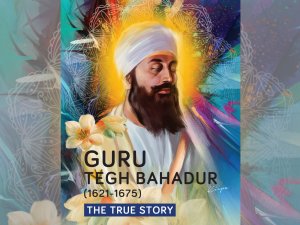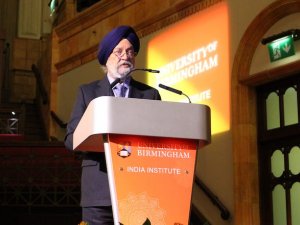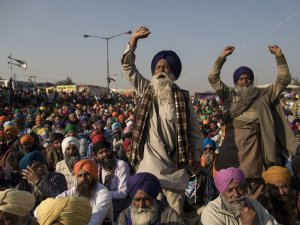Dya Singh’s Quest for Sikh World-Music
“These hymns and chants from Guru Nanak tradition are loved and cherished by millions of Sikhs and Guru Nanak followers around the globe.....This music has the power to promote deep relaxation, meditation contemplation and devotion, regardless of religion and cultural back ground.” (Film producer, Gurinder Chadha’s introduction to Dya Singh’s CD “Sacred Chants of the Sikhs” – a work in progress.)
On a sunny July,
2011, afternoon, my wife Harpal and I drove to a sleepy village near Stroud,
Gloucestershire, England, to pick up youngest brother Dya Singh.
Over a “cup of tea”
served in largish square mugs, his artiste host, Craig Pruess, invited me to
sit next to him in his home music studio. It was the best position for sound
reception as we listened to Dya Singh’s near-final version of Dukh Bhanjan
Tera Nam, .a thematic recording of about 35 Gurbani Shabads. (Remarkably
similar to those in Dukh Bhanjni Sahib!)
With one hand on the keyboard of an electronic device showing complex
sound-wave patterns, Craig made recording adjustments. In-between, he also
managed to tune his surmandal (Indian string instrument) to Gujri-Todi
raag base. It was agreed that surmandal should be used in certain
melodies. Dya Singh sat on a sofa at one end of the studio, listening
meditatively and making the occasional comment.
I was witnessing the finishing touches to a Sikh world-music recording – Dya
Singh version -by two world class artistes using the latest studio technology.
Dya Singh’s quest for distinctly Sikh world-music, which appeals to the
universal music ear, continues. Meeting Craig Pruess and working with him has
given a further musical dimension to this work in progress.
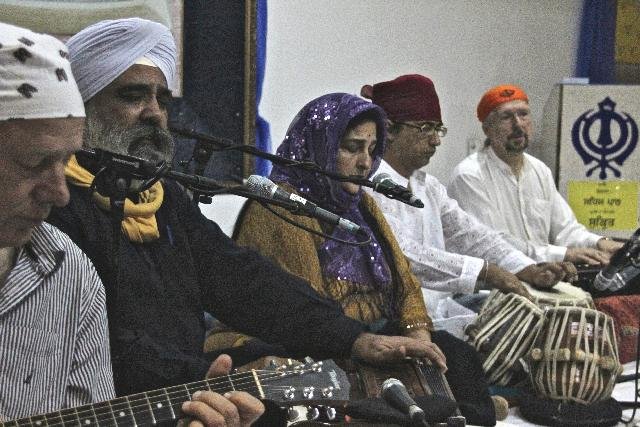
The opening quote from Gurinder Chadha is from the cover note of another CD
recorded by Dya Singh, promoted by Gurinder, and produced by Craig in a
series, Universal meditative chants from the Holy tradition of Nanak, or
just Sacred Chants of the Sikhs. It also aptly describes Dya Singh’s
journey and musical goal: to present Gurbani in world-music that “has
the power to promote deep relaxation, meditation contemplation and devotion,
regardless of religion and cultural back ground.” I have respect for
Gurinder’s phenomenal success in film making, if not for her expertise in any
field, especially in music! However, her interest in Dya Singh can only be
beneficial in his musical quest.
Craig has acquired international reputation as a producer and “arranger”
of music for almost all of Gurinder Chadha’s films since 1993 and also works
for the likes of Sir Cliff Richard. He is an accomplished multi-instrumentalist
equally versatile and creative with Eastern and Western musical traditions.
For the first time, Craig participated in Dya Singh group by playing the music
synthesiser in the Sacred Sites component of the Manchester
International Festival (MIF) from 6 to 10 July, 2011. It is with this
background and Dya’s chance (or destined?) meeting with Craig, that I sense a
next-step change in Dya’s quest for striking the right Sikh world-music
chord.
After about 14 years, once again I am prompted to write about Dya Singh’s
controversial presentation of Gurbani keertan (Sikh religious singing)
in the context of Indian and Sikh musical traditions. These traditions are
discussed at some length in a separate article, so that any criticism or praise
of Dya Singh (the group) is at least on an informed basis.
I first wrote about Dya Singh in 1997, when Dr Jagir Singh of Chandigarh was
visiting Australia for a wedding in the family. Following critical listening to
Dya’s earliest CDs like Gurbani Yatra, Mystical Traveller, Australian Sikh
Rhythm and Soul etc, the outcome was an article first published in Dr Jagir
Singh’s Amrit Kirtan, and later reproduced by some other journals.
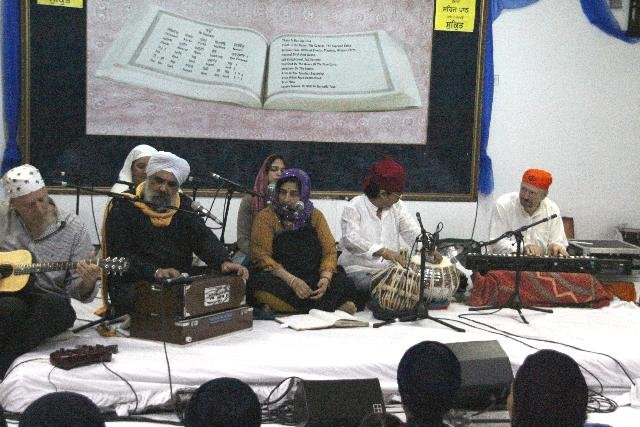
In August 2001, Dr I J Singh wrote an article about the controversy surrounding
Dya Singh with an apt title, “Give the man a break”. Whilst, he
supported Dya Singh's pioneering initiative to take Sikh music to mixed
audiences worldwide by re-tuning it to the Western ear, his support was
qualified. Like him, I too “come from a bias that likes to hear
every shabd sung in the raag specified for it in the Guru Granth."
However, he lamented, " But that is so rarely heard even from the
best-known traditional ragis.” Indeed, as mentioned in an article in “Amrat
Kirtan” at the time, very few professional raagis have mastered more
than about 4 raag ! Mostly they sing fixed tunes (bandash) in
various raag without much originality, and pass these on to next
generations. Of course, we have outstanding exceptions, and revered names like
Bhai Samund Singh, Bhai Santa Singh, Bhai Avtar Singh, Bhai Dharam Singh Jakhmi
and some contemporary classical raagis like Bhai Nirmal Singh, come
to mind.
The article in hand is prompted by what I see as a next step in Dya Singh’s
quest for peculiarly Sikh world-music capable of striking the right
universal chord, and which, in Gurinder Chadha’s words “has the power to
promote deep relaxation, meditation contemplation and devotion, regardless of
religion and cultural back ground.” Maybe, as a musical maverick, Dya Singh
would even say, regardless of the raag (shudh or misrat
ie. pure or mixed) in which it is sung! Increasingly, Dya Singh is on his own without much vocal support from his
highly talented daughters. Also, he is mostly working with local musical
talent wherever he goes. This change is exposing him to a greater variety of
music - both Sikh and non-Sikh; Eastern and Western. Not surprisingly, and
much against speculation, this change is for the better and brings him closer
to his world-music goal.
Increasingly, Dya Singh is on his own without much vocal support from his
highly talented daughters. Also, he is mostly working with local musical
talent wherever he goes. This change is exposing him to a greater variety of
music - both Sikh and non-Sikh; Eastern and Western. Not surprisingly, and
much against speculation, this change is for the better and brings him closer
to his world-music goal.
Although, his middle daughter, Harsel, accompanied him and is at her personal
best in the forthcoming CD, "Dukh Bhanjan Tera Naam", the
melodies are decidedly more appealing to the global ear. Craig's fine tuning
during the final stage would enhance that universal appeal.
Convergence of multi-faith music
Guru Nanak Sahib understood the great impact of Gurbani singing (keertan)
on the human mind and the “transformational effect of the voice when raised
in worship” (MIF web circular – see below). Thousands are spiritually
touched by the young Sikh men and women of the Sukrit Trust singing Nitnemto the accompaniment of a variety of musical instruments on Sikh TV
channels in the UK. When founders of this Trust nominated Dya Singh to
represent Sikh faith music at the Manchester International Festival (MIF), one
dryish comment was, “Well, did they have much of a choice?” It is true that
few, if any, Sikh classical raagis have made it to world stages with the
right music instrumental blends, and, in Gurinder Chadha’s words, “with
resonant and captivating voice” like Dya Singh’s.
One part of the recent Manchester International Festival (MIF) from 6th to 10th
July, 2011, was called Sacred Sites. To quote from the MIF Website, “Developed
by MIF Creative in close collaboration with faith communities across
Manchester, Sacred Sites invites those of any faith or none to experience the
sublime power of the human voice in a series of special performances.” This
was a low profile milestone achievement – a first - in the interfaith area,
which brought together diverse religious musical traditions under the wider
multicultural umbrella of an international festival. While there are attempts
to bring world religions around one table in today’s dangerous world, there is
also an increase in religious fanaticism. Low publicity for the event may have
been intentional!
Sacred Sites programme brought together, “five of the foremost
international performers of sacred song and recital for a week of extraordinary
events in Christian, Hindu, Islamic, Jewish and Sikh sites of worship across
the city.” Amongst these were, “Dya Singh (Shabads of Sikhism), Anuradha
Paudwal (bhajans of Hinduism) and Qari Syed Sadaqat Ali (koran recital and Sufi
poetry)” who enabled mixed congregations to experience “the sound and
transformational effect of the voice when raised in worship.”
The Sikh “Sacred Site” was Gurdwara Sri Guru Harkrishan Sahib Ji where
Dya Singh sang Gurbani Kirtan to the accompaniment of the traditional
harmonium and tabla, and other string and electronic musical instruments played
by world class maestros, also dedicated to the harmonisation of religious
music. They, visibly, represented the musical version of the original
“Parliament of World Religions,” which is Sri Guru Granth Sahib Ji. In
addition to Craig on the music synthesiser, the more familiar faces were
Dheeraj Shrestha (tabla) and Quentin Eyers (multi musical talent). Even the
much acclaimed Anuradha Paudwal was attracted to this assembly of artistes at
the Gurdwara Sahib in a special programme for children and young Sikhs.
Is Dya Singh and those in that ilk, doing something radical and revolutionary ?
Or, are they simply continuing with
music evolution – not unlike evolution of languages - over the centuries? In
order to understand the trends in Indian and Sikh musical tradition we need to
look back at the evolution in Indian and Sikh traditional music over the
centuries. This is a topic for a separate article.
Bouquets and brickbats!
In Dya Singh’s view, Gurbani sangeet , as distinct from raag basedGurbani keertan by professional raagis, aims not so much to
satisfy the technicalities, but more to provide a reasonably sound, practical
and simplified approach to the learning and appreciation of Gurbani raag. Even
classical music continues to evolve through exposure and through audience
demand. Presentation of Gurbani sangeet by Dya Singh’s international
music group is a part of this process. This effort does not compete with, but
complements the great contribution to Sikh music by professional raagis.
Yet, there have been instances when the latter show open resentment at Dya
Singh’s popularity before mixed audiences.
Above all, Dys Singh's music is overflowing with love. The power of the heavenly message of Gurbani sung to the accompaniment of a
variety of musical instruments touches every human soul. One view is that,
following in the footsteps of Guru Nanak Sahib and Bhai Mardana, Sikhi should
lead interfaith and world-music communication.  Dya Singh’s Sikh world-music adventure is controversial. It remains
controversial with me, his eldest brother! I agree with Dr I J Singh when he
writes, “Sometimes though, I think Dya Singh goes overboard......If a rendering
of a hymn connects the listener to the infinite that is fine, if it does not
then we need to recast the hymn in a different melody.”
Dya Singh’s Sikh world-music adventure is controversial. It remains
controversial with me, his eldest brother! I agree with Dr I J Singh when he
writes, “Sometimes though, I think Dya Singh goes overboard......If a rendering
of a hymn connects the listener to the infinite that is fine, if it does not
then we need to recast the hymn in a different melody.”
Yet, it is noticeable to the discerning musical ear, that, over the
years, his most severe critics have started imitating his style! That,
perhaps, is the best compliment for his ongoing quest to capture the universal
musical ear for disseminating the universal message of Gurbani. I do not
appreciate some of his recordings and always revert to traditional raagis
for prolonged periods, without listening to him. Recently when he was with me,
I repeatedly played Bhai Balbir Singh’s 31 Raag to him in my personal
mission to convert him back to traditional keertan! He listened to Raag
Maru with some interest, only because I mentioned that it was almost lost
to the Sikh musical tradition, which has also lost some popular folk dhunees
due to neglect by raagi ghranas.
Dya Singh’s Gurbani keertan, liberally flavoured with world-music and
sung in his powerful yet melodious voice is appreciatd by mixed world audiences.
If it can provide one with “a silent and still oasis in the frenetic and
busy world of ours” (Gurinder Chadha), then that should be welcome.
I am content to conclude with another quote from Dr I J Singh: “At the cutting
edge of a more progressive and questioning approach to 20th Century ritual
ridden Sikh institutions, Dya Singh continues happily to rouse strong emotions
amongst traditional Sikhs.....God gave him a mellifluous voice and talent
galore. So he performs keertan and gurbani sangeet as a mission.” (Dr I J
Singh “Give the man a break”)
Gurmukh Singh
Ret’d Principal(policy), UK Civil Service
E-mail: [email protected]


